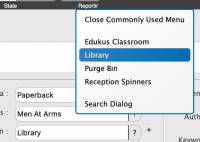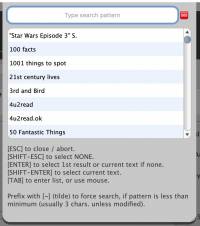Table of Contents
Mystic Help
Editing a Dynamic-Drop Down
Dynamic Drop-Down controls are similar in nature to drop-down controls, or combo text boxes that you may encounter in other applications.
Because of the nature of values that you may encounter in Mystic however, which may range from a few options to tens of thousands, and the needs to dynamically create new options of the fly (such as during cataloging), Mystic uses a custom control called the Dynamic Drop-Down.

Selecting from a Small Range
 If the likelihood of a particular range of values is relatively small, the Dynamic Drop-Down will attempt to provide an immediate list of common values to choose from. It does this by providing a context-menu when you click the [?] part of the drop-down.
If the likelihood of a particular range of values is relatively small, the Dynamic Drop-Down will attempt to provide an immediate list of common values to choose from. It does this by providing a context-menu when you click the [?] part of the drop-down.
The drop-down will display the top uses of values in the list (usually the top 10), and presents them in an alphabetically ordered menu. The user can opt to close the window without selecting a new value, or to start the full search dialog (see below) to search the full range of possible values in that area.
Selecting From A Large Range
If the range of possible options is excessive (such as Series Title or Keywords), clicking the [?] part of the drop-down will display a dialog to allow a full search of the possible values. The dialog is also displayed if you select the [Search Dialog] option from the context sensitive menu (see above).
Depending upon the nature of the options requested, the list may remain empty on initial display of the dialog or may load all of the values possible. In order to perform a search for possible values or to otherwise filter the list of values being displayed, enter text into the search pattern field.
In order to select an option, double-click the value in the list.
A number of additional operations can be triggered from with thin the search field using the keyboard:
[ESC]
Pressing the escape key will close the dialog without performing any action. The currently selected value in the drop-down will be unchanged.
[SHIFT]-[ESC]
Pressing the escape key with the [SHIFT] key at the same time selected the 'none' value. The current value in the drop-down is removed and replaced with no value selected.
[ENTER]
Pressing the enter (return) key can have one of two possible actions:
- If there is a single value in the list, that value is selected and returned to the drop-down.
- If there are no matching results in the list, pressing enter (return) signifies that you want the current text entered to represent a new value in the list - the value is created and passed back to the drop-down as the new selection.
[SHIFT]-[ENTER]
Usually, text entered in the search is shorter than the possible options - entering 'america' for example would find 'american', 'south america', 'america dance' etc. and display these in the results list. Unfortunately, this effectively prevents the new text (america) from being selected or created as a new entry as pressing [ENTER] by itself will select the first entry in the list.
By pressing [SHIFT]-[ENTER], you tell the dialog that you want to select and create the current value, as it currently exists in the search text field.
Using the ~ (tilde) Prefix
Usually, the search field will only perform actions with a minimum number of characters entered (usually more than 3). This reduces the number of searched and the amount of data passed back to the list when the range of possible options is exceptionally high. By entering the tilde (~) character at the beginning of the text, a search is forced regardless of the the text length, even if it less than the minimum - this enabled searches of words such as 'US', 'UK', 'SAS', 'FBI' etc.
Selecting from the Text Field
Many experienced staff members can catalogue entirely using the keyboard - it often proves a faster way of data entry, avoiding the need to move the hand from keyboard to mouse.
To assist this method of operation, drop-down lists also support the ability to perform searches purely triggered by keyboard activity.
To do this, [TAB] into a drop-down in the same way as moving between other controls. Starting to type characters other than the [TAB] key will automatically display the search dialog (see above).

